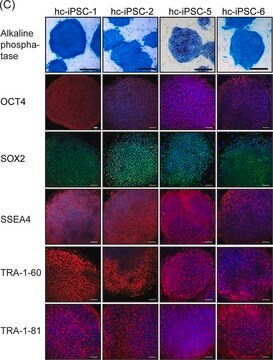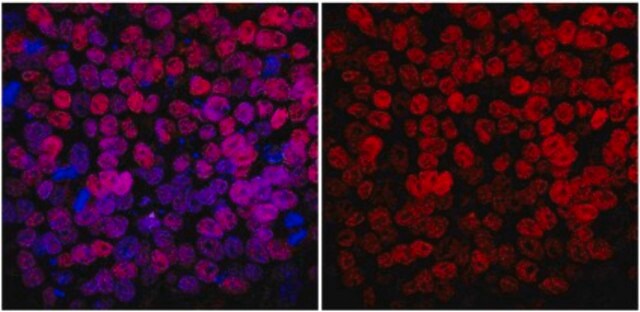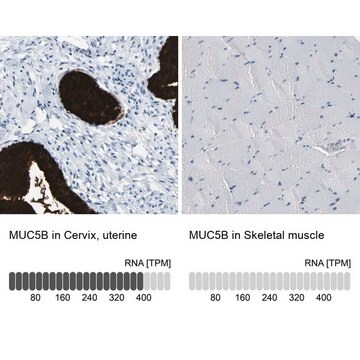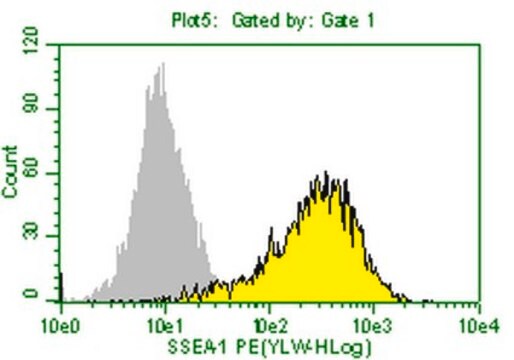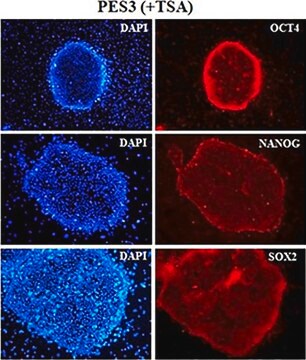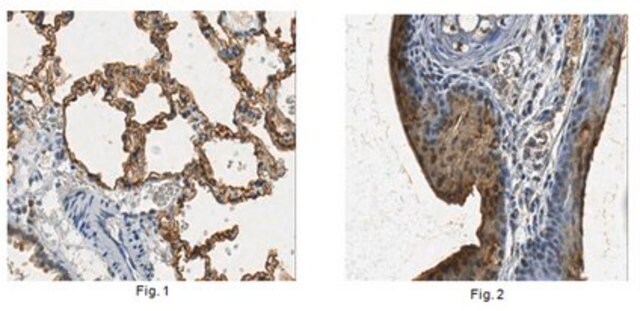推荐产品
生物源
mouse
品質等級
共軛
PE
抗體表格
purified antibody
抗體產品種類
primary antibodies
無性繁殖
MC-813-70, monoclonal
物種活性
human
製造商/商標名
Milli-Mark®
技術
flow cytometry: suitable
immunocytochemistry: suitable
同型
IgG3κ
運輸包裝
wet ice
目標翻譯後修改
unmodified
基因資訊
human ... FUT4(2526)
一般說明
N-terminal GST-tagged, recombinant human MuRF1 full length, expressed in E.coli. Purified using glutathione sepharose.
The cell-surface markers used routinely to identify undifferentiated human embryonic stem cells (hESCs) were initially characterized as markers for mESCs, mouse embryonic carcinomas (ECs), or human EC cells. Stage-specific embryonic antigen-3 (SSEA-3) and SSEA-4 are widely used as cell-surface markers to define both human and mouse ESCs. SSEA-3 and SSEA-4 are expressed on undifferentiated hESCs but not on undifferentiated mESCs.
特異性
This antibody reacts with the stage-specific embryonic antigen-4 (SSEA-4) that is expressed upon the surface of human tetracarcinoma stem cells (EC), human embryonic germ cells (EG) and human embryonic stem cells (ES).
No immunoreactivity is evident with undifferentiated murine EC, ES and EG cells. Expression of SSEA-4 is down regulated following differentiation of human EC cells. In ctontrast, the differentiation of murine EC and ES cells may be accompanied by an increase in SSEA-4 expression.
No immunoreactivity is evident with undifferentiated murine EC, ES and EG cells. Expression of SSEA-4 is down regulated following differentiation of human EC cells. In ctontrast, the differentiation of murine EC and ES cells may be accompanied by an increase in SSEA-4 expression.
免疫原
Human embryonal carcinoma cell line 2102Ep.
應用
Immunocytochemical staining of live H9 human ES cells incubated for 30 minutes at 37oC with 1:50 dilution of anti-SSEA-4, clone MC-813-70, PE conjugate (Cat. No. FCMAB116P) monoclonal antibody.
Pluripotent human ES cells exhibit strong immunoreactivity to this antibody.
Immunocytochemical staining of fixed H9 human ES cells incubated for 2 hours at 2-8oC with 1:50 dilution of anti-SSEA-4, clone MC-813-70, PE conjugated (Cat. No. FCMAB116P) monoclonal antibody.
Pluripotent human ES cells exhibit strong immunoreactivity to this antibody.
Pluripotent human ES cells exhibit strong immunoreactivity to this antibody.
Immunocytochemical staining of fixed H9 human ES cells incubated for 2 hours at 2-8oC with 1:50 dilution of anti-SSEA-4, clone MC-813-70, PE conjugated (Cat. No. FCMAB116P) monoclonal antibody.
Pluripotent human ES cells exhibit strong immunoreactivity to this antibody.
Research Category
Stem Cell Research
Stem Cell Research
Research Sub Category
Pluripotent & Early Differentiation
Pluripotent & Early Differentiation
This Milli-Mark Anti-SSEA-4-PE Antibody, clone MC-813-70 is validated for use in FC, IC for the detection of SSEA-4.
外觀
Protein A purified
Purified mouse monoclonal IgG3 conjugated to PE fluorochrome in PBS with less than 0.09% sodium azide and 15 mg/mL BSA.
儲存和穩定性
Maintain refrigerated at 2-8oC protected from light in undiluted aliquots for up to 6 months from date of receipt.
分析報告
Control
Pluripotent human embryonic stem (ES) cells
Pluripotent human embryonic stem (ES) cells
法律資訊
MILLI-MARK is a registered trademark of Merck KGaA, Darmstadt, Germany
免責聲明
Unless otherwise stated in our catalog or other company documentation accompanying the product(s), our products are intended for research use only and are not to be used for any other purpose, which includes but is not limited to, unauthorized commercial uses, in vitro diagnostic uses, ex vivo or in vivo therapeutic uses or any type of consumption or application to humans or animals.
Not finding the right product?
Try our 产品选型工具.
儲存類別代碼
10 - Combustible liquids
水污染物質分類(WGK)
WGK 2
閃點(°F)
Not applicable
閃點(°C)
Not applicable
Vanessa Sauer et al.
Cell transplantation, 25(12), 2221-2243 (2016-08-12)
Although several types of somatic cells have been reprogrammed into induced pluripotent stem cells (iPSCs) and then differentiated to hepatocyte-like cells (iHeps), the method for generating such cells from renal tubular epithelial cells shed in human urine and transplanting them
我们的科学家团队拥有各种研究领域经验,包括生命科学、材料科学、化学合成、色谱、分析及许多其他领域.
联系技术服务部门